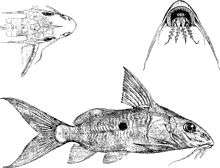Synodontis nummifer
Synodontis nummifer, known as the two spot synodontis,[1][2] is a species of upside-down catfish native to the Congo Basin of Cameroon, the Democratic Republic of the Congo and the Republic of the Congo.[3] It was first described by the Belgian-British zoologist George Albert Boulenger in 1899, based upon a holotype discovered in Léopoldville, Belgian Congo.[2] The specific name "nummifer" comes from the Latin for "to bear a coin", which refers to the large spots on its sides.[1]
| Synodontis nummifer | |
|---|---|
 | |
| Scientific classification | |
| Kingdom: | Animalia |
| Phylum: | Chordata |
| Class: | Actinopterygii |
| Order: | Siluriformes |
| Family: | Mochokidae |
| Genus: | Synodontis |
| Species: | S. nummifer |
| Binomial name | |
| Synodontis nummifer Boulenger, 1899 | |
Description
The body of the fish is olive colored on the back transitioning to whitish on the underside.[4] The sides of the fish have a large round black spot on each side, above the lateral line, and frequently a second spot above the base of the anal fin.[4] The pigmentation of the head is spotted.[2]
Like other members of the genus, this fish has a humeral process, which is a bony spike that is attached to a hardened head cap on the fish and can be seen extending beyond the gill opening.[1] This process is broad and rounded at the end, and extends as far as the occipito-nuchal process.[4] The first ray of the dorsal fin and the pectoral fins have a hardened first ray which is serrated,[1] as long or a little longer than the head.[4] The caudal fin is very deeply forked.[4] It has short, cone-shaped teeth in the upper jaw.[1] In the lower jaw, the teeth are s-shaped and movable.[1] The fish has one pair of maxillary barbels, with broad membranes at the base, as long as the head or slightly shorter,[4] and two pairs of mandibular barbels that are often branched.[1][2] The adipose fin is about four times as long as it is deep.[4] The pectoral spine is a little shorter than the head, and strongly serrated on both sides.[4]
This species grows to a length of 17.5 centimetres (6.9 in) SL although specimens up to 20.5 centimetres (8.1 in) TL have been recorded in the wild.[1][3]
Habitat
In the wild, the species inhabits tropical waters with a temperature range of 22 to 25 °C (72 to 77 °F), a pH of 6.4 – 7.2, and dH range of up to 18.[3] It has been found throughout the Congo River basin, but not the southern tributaries of the Congo River.[5]
Parasites
As other fish, Synodontis nummifer harbours parasites, including species of the monogenean genus Synodontella.[6]
References
- "Synodontis nummifer Boulenger, 1899". Planet Catfish. 17 Jan 2009. Retrieved 17 October 2016.
- "Synodontis nummifer Boulenger, 1899". scotcat.com. Retrieved 17 October 2016.
- Froese, Rainer and Pauly, Daniel, eds. (2016). "Synodontis nummifer" in FishBase. June 2016 version.
- Boulenger, George Albert (1909). Catalogue of the fresh-water fishes of Africa in the British museum (Natural history). London: British Museum. pp. 463–465.
- Moelants, T. (2010). "Synodontis nummifer". IUCN Red List of Threatened Species. 2010: e.T182684A7942307. doi:10.2305/IUCN.UK.2010-3.RLTS.T182684A7942307.en. Retrieved 15 January 2018.
- Mbondo, Jonathan A.; Nack, Jacques; Bitja Nyom, Arnold R.; Pariselle, Antoine; Bilong Bilong, Charles F. (2019). "New species of Synodontella (Monogenea, Ancyrocephalidae) gill parasites of two Synodontis spp. (Pisces, Mochokidae) from the Boumba River (Congo Basin, East Cameroon)". Parasite. 26: 37. doi:10.1051/parasite/2019037. ISSN 1776-1042. PMID 31246168.
External links
![]()
